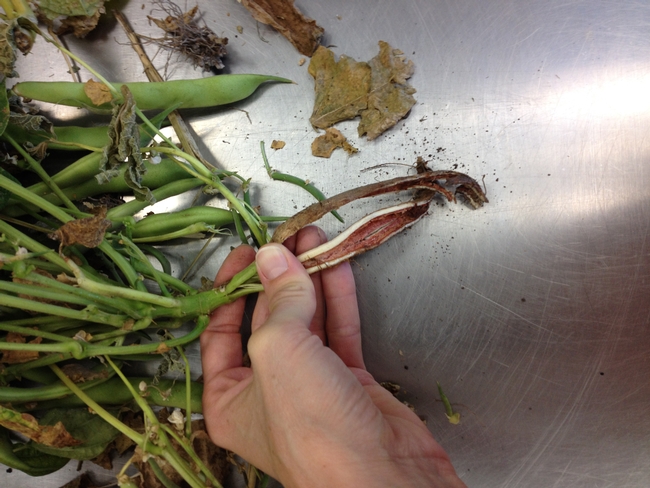In late August, I visited a kidney bean field that was exhibiting stress symptoms, like necrotic leaves and stunting. Even though the field was near harvest, the consultant asked if I would take a look at it. Upon pulling up some plants, I noticed some brick red lesions on the roots, and when I pulled the roots apart, I saw that the brick red color ran the length of the conducting tissue. This is characteristic of Fusarium root rot (Fusarium solani).
Fusarium root rot can be a problem in mid- to late- season beans but generally only when the plants are experiencing some other stress. The other stresses may include lack of moisture, too much moisture (and low oxygen), poor nutrition, or salinity. I will speak to salinity below. Fusarium root rot chlamydospores can survive in soil for years, so the UC IPM recommendations are to rotate out of beans for at least three years. While there are no resistant varieties, some varieties are more tolerant than others, so check with your seed supplier for variety recommendations.
In the case of this field, I wondered whether salinity was the stress that encouraged the Fusarium root rot. Beans are considered sensitive to salinity, with yield reductions expected when the electrical conductivity of the soil saturated paste (ECe) exceeds 1.0 dS/m or when the electrical conductivity of the seasonal average applied water exceeds 0.7 dS/m. I sampled soil from about the top eight inches and found the ECe to be 1.025 dS/m. This barely exceeds the guideline salinity target, but it indicates that salinity could have been contributing to plant stress. The crop consultant was going to follow-up by testing the irrigation water salinity. Overall, I hope that winter rains will come and leach the salts below the root zone; nevertheless, the presence of Fusarium root rot would guide me away from planting beans in this field for a few years.